Nothing ruins your day like discovering you have new creepy, crawly, and unwelcome tenants in your home. We’re talking about cockroaches, a household pest so common that up to 63% of American homes are expected to experience them. Worse yet, there are several different kinds of roaches that you may encounter in your home, two of the most common being American cockroaches and German cockroaches. But what’s the difference? And does it matter?
.jpg?width=250&height=167&name=madagascar-cockroach-2022-10-31-07-38-17-utc%20(1).jpg) Madagascar Hissing Cockroach (not native to the US)
Madagascar Hissing Cockroach (not native to the US)
What are cockroaches?
Cockroaches, often referred to simply as roaches, are a type of insect belonging to the Blattodea order. There are about 4,600 different species of roaches, but only 30 are likely to be encountered in human habitats. Out of these 30, only a handful are considered to be true household pests - American and German roaches, for example.
Cockroaches are actually an incredibly old (ancient, really) group of insects whose ancestors originated roughly 320 million years ago. These early roachoids are surprisingly similar to the modern roach, with just a few evolutionary adaptations. Modern cockroaches have an internal organ used for egg-laying purposes called ovipositors that their ancestors lacked. The chewing mouthparts roaches utilize for consuming their omnivorous diet are among the most primitive of all flying insects. Their longstanding existence has provided them a survival advantage, resulting in a remarkably hardy insect that can survive in various environments, from the Arctic to the topics.
The cockroach’s resilience has led to the commonly held belief that a cockroach could survive a nuclear bomb. While it’s true that roaches can withstand radiation levels that would surely kill humans, they are not completely impervious to radiation. It’s estimated that about 20% of cockroaches can survive an atom-bomb level of radiation, with some even being about to withstand up to the 100,000 rad level. In fact, cockroaches were among the only survivors of the 1945 Hiroshima atomic bomb, with reports of the insects crawling among the rubble just 1000 feet from the blast site. It should be noted that cockroaches are not impervious to the blast impact a direct hit from a nuclear bomb would cause, and they are also not capable of withstanding the extreme heat delivered by a nuclear blast. Cockroaches are hardy, but not that hardy.
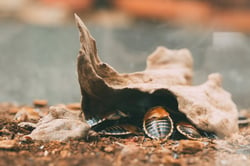 Fulvous Wood Cockroach
Fulvous Wood Cockroach
What is an American Cockroach?
The American cockroach is the largest of the common roach species and is considered to be a true pest. In some regions, the American cockroach is also known as a waterbug (though not aquatic), a ship roach, a kakerlac, or a Bombay canary. They are also commonly confused with a palmetto bug, a roach of similar size and coloring that lives among a palmetto tree’s fan-like leaves. Some larger June bugs can also be mistaken for American roaches.
Contrary to what their name suggests, American roaches are actually native to the Middle East and Africa. It’s thought that they appeared in the Americas around the 17th century due to commercial trade patterns. As a result of global commerce, American roaches can be found practically everywhere in the world, thriving in both the extreme cold and heat. This widespread distribution is commonly referred to as cosmopolitan distribution.
American roaches are around 4cm long on average and molt anywhere from 6-14 times in its lifetime; they have the longest life cycle of roaches, up to 700 days. They are reddish brown in color with some yellowish demarcation just behind the head. Immature or non-adult roaches very closely resemble mature roaches, however they are wingless. Interestingly, immature roach nymphs can regenerate limbs as needed, while adults cannot.
Like most roaches, the American cockroach can move very quickly. In fact, it is considered to be one of the swiftest running insects, moving at about 50 body lengths per second. For perspective, this would be the equivalent of a human running at 210 mph! They are also capable of squeezing into small cracks and crevices to hide despite their bulky size. While American roaches typically live outdoors, once they enter your home, they're unlikely to leave on their own accord.
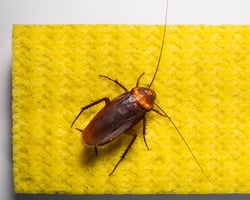 American Cockroach
American Cockroach
What is a German Cockroach?
The German roach is considerably smaller than the American roach, typically growing to be just half an inch long on average. German roaches are also commonly referred to as croton bugs, a name that came about in the 19th century. These insects range in color from tan to black with two darker, nearly parallel stripes along the pronotum, or area just behind the head. Although German roaches have wings, they are very weak fliers and are known to only “glide” when disturbed, incapable of flying long distances. They are frequently mistaken for Asian cockroaches as they are nearly identical to the casual onlooker, however Asian cockroaches are drawn to light much like moths and are adept fliers.
German roaches are widely considered to be the insect that gives roaches a bad name. They are the more troublesome household pests of all roach species and are very common in a variety of human-inhabited buildings. In fact, they are not very common in the wild at all and their preferred living environment is indoors. German roaches are known to infest a variety of structures including hospitals, nursing homes, restaurants, hotels, and personal residences such as apartments, townhomes, or single-family homes. Living so close to humans is exactly how they tend to be spread. German roaches can be transported through grocery stores, casual visits from neighbors, and by hitching a ride. They can even travel through extensive pipe or drain systems!
Despite all roaches being nocturnal insects, German roaches are one of the few species that will venture out during daylight hours. This becomes especially common when the roach population reaches levels of overcrowding, or living areas are disturbed (such as during removal efforts.)
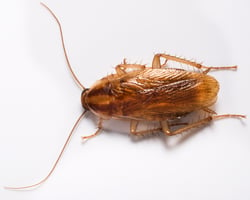 German Cockroach
German Cockroach
Why do I have roaches in my home?
Both American and German roaches tend to seek out homes for the same three reasons: food, water, and shelter. Indoor settings are a great place for roaches to thrive, particularly in residential homes where food is plentiful, water is readily available, and the outdoor elements are not a concern. There are very few natural predators for roaches when living indoors (besides humans themselves) and many opportunities to hide away from watchful human eyes. It’s incredibly easy for American and German roaches alike to live undetected in a home for long periods of time. Homeowners are often unaware of their presence until an infestation has occurred, forcing roaches out of hiding spots and requiring them to risk discovery in search of diminishing food and water supply.
A common myth is that cockroaches only infest dirty or unkempt homes. This is simply not true. Cockroaches will infiltrate homes for a variety of reasons and some homes are more susceptible than others. American roaches in particular are generally considered regional problem pests, popping up in homes primarily in the southeastern United States. Homes in Georgia, Florida, and Alabama are especially susceptible to American roaches due to their high concentration and population in these areas.
Because roaches are omnivorous scavengers, they are often insects of opportunity. This means that any opportunity a roach has to enter your home, they probably will. This can occur through a variety of circumstances. Many cockroaches gain entry through cracks in your home’s foundation or slipping through damaged siding. They can also skitter under doors with insufficient door sweeps or crawl through damaged window screens. Gaps where utilities enter the home can also provide cockroaches a potential entry route. In truth, a home with any small crack, gap, or crevice in its exterior (whether they’re aware of it or not) may be susceptible to cockroaches.
German roaches are more likely to be drawn to and actively seek out homes where food is readily available to them. This is why they tend to be anecdotally associated with "dirty" homes, though this isn't always the case. German roaches will gladly seize the opportunity to feast on even the smallest of crumbs or spills - a great example of this is the area around a kitchen trash can where scraps may fall behind the bin, unnoticed. The best ways to ensure your home remains unhospitable to a German roach is to clean up spills immediately, sweep your kitchen floors every night, and never leave dirty dishes in the sink or counter overnight.
Both American and German roaches need moisture to survive. Even the cleanest of homes can experience a roach infestation if they have a leaky faucet, air conditioners with dripping condensation, or a basement with either no dehumidifier or one inadequate for the space. Roaches will even drink water left on the floor of your shower or tub and sneak sips from a pet’s water dish.
Seemingly spotless homes may not be safe from roaches either. The ever-resilient roach is more than happy to find nourishment in even the most unlikely of places. American and German roaches can make a meal out of cardboard, wallpaper, books, oil and grease, leather products, soap, and even human hair! (Gross, we know.) Roaches, arguably the least picky of eaters, will thrive equally in spotless homes as they do in untidy homes.
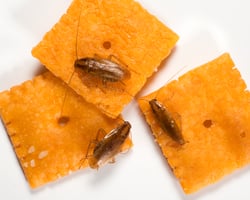 German roaches on crackers
German roaches on crackers
What kind of damage do roaches cause?
While roaches are unlikely to cause significant damage to the structure of your home, your valuable personal belongings are at risk during a roach infestation. Photo albums, important documents, and other leather or fabric memorabilia can be destroyed during a roach infestation. When roaches aggregate in large numbers, as they so often do, damage to belongings can happen quickly. Especially in instances where the roaches are present in areas of storage that are not frequented by human activity, roach damage can be extensive.
However, the real threat of roaches is their ability to spread disease and illness.
Roaches are known for carrying and spreading a multitude of nasty diseases and illnesses that can impact humans. American and German roaches can transmit a number of diseases by leaving germ-ridden tracks around your home. Countertops, cutlery, and even glassware are all common areas in which transmission is common. Some diseases roaches can spread are:
- Campylobacteriosis
- Giardia
- Cholera
- Gastroenteritis
- E. Coli
- Leprosy
- Listeriosis
- Typhoid fever
- Dysentery
- Salmonella
If you suspect you have been affected by a roach-related disease, please seek medical attention immediately.
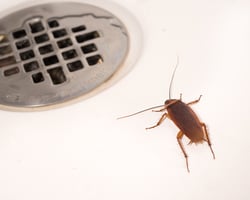 German roaches are attracted to shower drains due to the moisture.
German roaches are attracted to shower drains due to the moisture.
How do I get rid of a roach infestation?
Whether you’re experiencing an American or German roach infestation, we highly recommend you contact a trusted pest professional for immediate removal. Roaches are notoriously difficult to get rid of and rarely respond to DIY attempts. DIY roach treatments may kill a few roaches on contact but is more likely to just push the population deeper into hiding, certain to return once deemed safe. Due to the roach’s incredible biological makeup, prolific reproduction cycle, and immunity to many insecticides, they are an adversary best dealt with by the professionals.
Removing roaches from your home can be a lengthy process to ensure the insects are fully eradicated. It also includes equal commitment from both your chosen professional and you as the homeowner. Quality pest control companies should inform you that fully eradicating roaches is a process; while companies may target the existing adult roach population, it's nearly impossible to exterminate every adult roach in a single service due to their ability to hide within walls and other unreachable areas. EcoShield also targets eggs that may be out of sight at the moment but will soon result in another wave of roach invaders. Still yet, EcoShield addresses potential entry points where the roaches may have gained entry.
Customers should be aware that if they don't adhere to the necessary sanitation plan EcoShield recommends, it's likely the roaches will return. This is why permanent roach eradication is very much a collaborative process between EcoShield and the customer. Our goal is to not only successfully get rid of your current cockroach infestation, but also prevent any future infestations.
If you’re currently experiencing a roach infestation in your home, contact EcoShield immediately for a free no obligation quote. With EcoShield’s Home Protection Plan, we not only remove the existing cockroach infestation, but we also disrupt the roach lifecycle and address target locations in your home to prevent future infestations. This service protects you not only from cockroaches but a multitude of other creepy crawlies that frequently enter homes.
Call us today or fill out the form on this page to be connected with our trusted pest professionals.